A Walkabout Wallabout
OpenHouseNewYork (OHNY), a group focused on New York City's architecture and design, has organized this as the 4th Annual OpenHouseNewYork Weekend. Billed as "America's largest architect and design event," the Weekend offers free tours of dozens of sites around the city, many of them usually closed to the public.
I was unaware of OHNY or the event, scheduled for today and tomorrow, until late last night. When I went to OHNY Web site to investigate the available tours, I found that most of the best-known, least-accessible buildings were already full to capacity. Searching for a tour that I could join, I discovered the Wallabout neighborhood.
Even if you've never set foot in New York, you've probably seen and heard of certain iconic locations ― the Statue of Liberty, the Empire State Building, Greenwich Village, Times Square. But even natives are unfamiliar with some areas of the city, and the Wallabout neighborhood is firmly among the obscure.
The area borders three districts burgeoning with new historic and commercial interests ― Fort Greene, Clinton Hill and the Brooklyn Navy Yard ― but even its closest neighbors don't know Wallabout's name or its story.
The name comes from the location; this section of Brooklyn is built on a parcel of land purchased in 1637 from the Dutch West India Trading Company by Walloon (Belgian) Jansen de Rapeljein. The river inlet bordering his land became known as Wallabout Bay (from Waal Boght, "Bay of Walloons").
During the 1700s, Wallabout Bay was the site of one of the greatest tragedies of the American Revolution when 11,000 men died on British prison ships moored in the East River. Most of their corpses were thrown overboard and, for many years afterwards, their bones washed up on the muddy shore.
Five years after the establishment of the United States, the first shipyard was built on Wallabout Bay. In 1801 the federal government purchased the land and the shipping works and established what would come to be known as the Brooklyn Navy Yard.
As the shipyard developed, commercial interests related to the docks began to spring up in the surrounding area, resulting in factories and warehouses for the goods being shipped and low-cost housing and taverns for the shipworkers. Those bustling streets, just beyond the walls of the Navy Yard, were dubbed the Wallabout district.
There was never a reason for tourists to flock to this modest, hidden neighborhood. This was never a fashionable location. The houses, while often attractive and comfortable, were never populated by socialites or bankers; the shops, while serviceable, never included fine jewelers or chic dressmakers; the amenities, while adequate, never featured museums or theatres.
The houses here were always, in every respect, in the shadows of the shipyards, warehouses and factories. Because the district was defined by industry, not ethnicity or economic status, it lacks a clearly defined culture and identity.
Two major events transformed Wallabout and led it even deeper into obscurity: first, in the 1940s, World War II, great swathes of the industrial area (including most of the Dutch-style marketplace) were torn down to make way for America's urgently expanded shipbuilding efforts; secondly, in the 1960s, the construction of the massive Brooklyn-Queens Expressway (BQE), during which block after block of housing was razed in the name of "progress" and "slum clearance." The building of the BQE not only destroyed streets and houses, it eliminated an source of public transportation, bisected the area and cut neighbor off from neighbor.
Today, a small band of activists and advocates are working to have Wallabout named as a Landmark district. This designation would help homeowners restore some of Brooklyn's oldest wood framed houses, which today are often decaying and crumbling, while preserving more of the area's rapidly disappearing industrial landscape.
Ironically, the most neglected houses in Wallabout are also among those most likely to still retain their original architectural details; their owners, either through neglect or lack or resources, failed to follow the lead of neighbors who have stripped away delicate ironwork, hidden carved stone under vinyl siding, replaced stained glass with factory-made windows and, strangely enough, covered solid bricks with brick veneers and layers of stucco.
Today's tour, led by an historic preservationist from the Pratt Institute, working with the Myrtle Avenue Brooklyn Partnership, took us past former candy factories and cold-storage warehouses, charming cottages and crumbling churches, tidy homes and neglected gardens, empty lots, litter-strewn housing projects and well-maintained apartment buildings.
At the end of the program, the group turned onto Ryerson Street, site of the last surviving home of America's greatest poet, Walt Whitman. There, we were greeted by representatives of the Walt Whitman Project, who ― to the surprise and delight of the tour group and the area's residents ― read to us from the 1856 edition of Whitman's masterpiece, Leaves of Grass.The sum of all known reverence I add up in you, whoever you are;
The President is there in the White House for you--it is not you who are
here for him;
The Secretaries act in their bureaus for you--not you here for them;
The Congress convenes every twelfth month for you;
Laws, courts, the forming of States, the charters of cities, the going and
coming of commerce and mails, are all for you.
List close, my scholars dear!
All doctrines, all politics and civilisation, exsurge from you;
All sculpture and monuments, and anything inscribed anywhere, are tallied in you;
The gist of histories and statistics, as far back as the records reach, is in you this hour, and myths and tales the same;
If you were not breathing and walking here, where would they all be?
The most renowned poems would be ashes, orations and plays would be vacuums.
All architecture is what you do to it when you look upon it;
Did you think it was in the white or grey stone? or the lines of the arches and cornices?
All music is what awakes from you, when you are reminded by the instruments;
It is not the violins and the cornets--it is not the oboe nor the beating drums, nor the score of the baritone singer singing his sweet romanza--nor that of the men's chorus, nor that of the women's chorus,
It is nearer and farther than they.
Heading into the 'hood under the BQE 

The grandest house in the neighborhood 

The shabbiest house in the neighborhood 
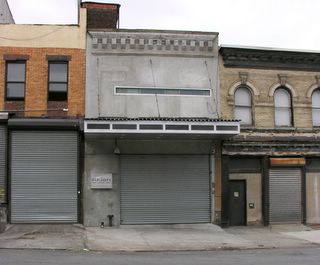
Few awnings remain in the old marketplace 
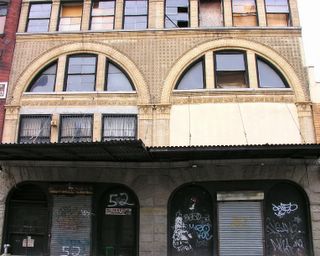
A warehouse with an awning and terracotta tiles 
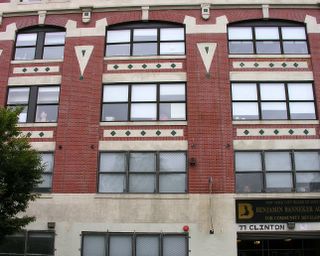
77 Clinton Ave., former bakery building 
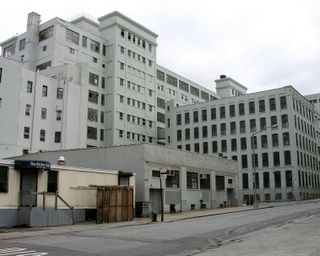
Site of the Rockwell Candy factory 

The site of former stables on Waverly Ave. 

Vinyl siding covers a wooden house 
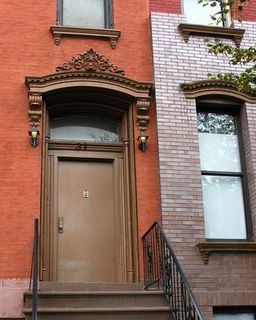
Left, brick & ironwork; Right, brick veneer 

The last remaining tenement 

A brick & brownstone doorway 

Apartment building doorway carved with dragons 

An original doorway and glass-paned door 

A rotting front stoop 

99 Ryerson Street, Walt Whitman's house 
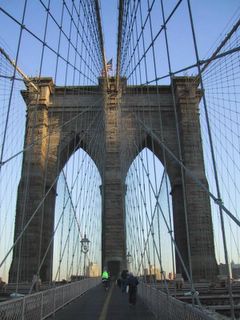


4 Comments:
I like these kind of neighborhoods where "ordinary folks" live. Whenever my wife and I walk through Beijing, we always gravitate towards the old-fashioned Houtong neighborhoods. Last night we had a long walk around the Tibetian Buddhist temple neighborhood, through different alleyways, past some tea houses and a practice session for Chinese opera. Of course it's easy for outsiders to romanticize these neighborhoods -- we don't see from the outside that many houses there lack indoor bathrooms (hence the public toilets on every street) or even running water (so you have to go to the communal supply). They can be messy, dirty, crowded and noisy. But they are more human somehow than the "meat storage units" that modern developers are putting up all over the place.
Thanks for visiting my blog! :)
I especially like the photographs of the old doorways, it seems an echo of the people who once lived there. They serve as a reminder of the quiet soul of the city, a contrast to the hard and glittery facade that sometimes presents itself to the world. I sometimes feel as though Brooklyn would have done better on her own, rather than entering into such a marriage of convenience.
Many thanks for a wonderful and well-written entry about Wallabout. I used to live near there and was always quite intrigued by the age-span of the architecture. One little thing, that photo is on Clinton AVE, not Clinton ST (which is in Brooklyn Heights). Thanks again!
Thanks to the anonymous poster (above) for pointing out my error in writing "Clinton Street" instead of "Clinton Avenue." I appreciate the comments and have made the correction.
Post a Comment
<< Home